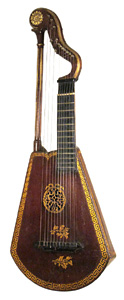|
Organology: Harp Guitar "Relatives" Note to the casual reader or researcher: This Reference Gallery also features historical instruments that are not harp guitars, but “relatives” or distant “cousins” – presented on Harpguitars.net for historical and organological comparison.
Harp-lutes UPDATE 2025: December, 2014 saw the publication of The Grove Dictionary of Musical Instruments (Second Edition), for which I was asked to edit the "Harp-lute" entry, along with "Light, Edward" and "Ventura, Angelo Benedetto." Subsequently, a much more thorough and accurate PhD thesis was completed by my friend Hayato Sugimoto, which was eventually archived online here. Even that exhaustive work is incomplete as so many more specimens and information have come to light. For example, the fact that Edward Light had a New York distributor, and most importantly, the investigation into the "Regency lute" by Taro Takeuichi. This invention may have been concurrent with Light's own original invention, the "harp-guitar." Light's invention was once circa dated at 1798, but now only given as "c.1800," the first advertisements being from that year, but I believe the evidence strongly points to Light experimenting with gut-strung "guitars" much earlier. As for Takeuchi's research, this "lute" was quite possibly introduced by Joseph Buchinger, a luthier student of Michael Rauche, who built wire-string guittars. (As a musician and musical instrument dealer, Light was also well acquainted with guittars and harps). Interestingly, Lights inventions would be predominately built by Alexander Barry, a harp maker and coincidentally then-recently Buchinger's son-in-law! Regardless of precise timing, Takeuchi's "Regency lute" is now shown second below, replacing another specimen I had originally included, labeled at the time "harp-theorbo," for want of a better name (some had also used "arch-cittern"). Takeuchi mentions Sigimoto's term "arch-lute-guittar" (which I quite like) but instead chose the term "Regency lute." In historical terms, it was almost always simply referred to as the "lute" (not exactly descriptive!). While the term "Harp-lute" refers to a specific form of later Edward Light instrument, I have long thought that it is also the term that should be used in the broader sense as a family name to include all the Light inventions, the "Lute," and the many subsequent copies and variations by other makers. All appear to have been made in the 1800-1830 period, generally in London (the final Levien in Paris). Again, Edward Light is believed to have been the original and most prolific harp-lute inventor, though we must perhaps acknowledge Buchinger and the other builders of and composers for the competing "Lute" - with competition from Clementi, Harley, Levien, Packer, Wheatstone, Ventura, several lesser-known makers, and finally, Levien again in Paris, while Ventura continued his London inventions even into the 1850s. As shown below, concurrently or possibly soon before, the original "proto" harp-lute was named the "Harp-Guitar" (originally the "harpinated guitar") and was a distinct new instrument with its own form and construction that borrowed its tuning not from the guitar, but from the guittar (English Guittar), technically a form of cittern. Thus the harp-lutes had their own tuning and tradition of musical literature, completely separate from the Spanish guitar. On Light's instruments, additional floating strings were soon added alongside the fretted neck (the "lute" having them from the outset). These were then added in increasing quantity until eventually the frets disappeared almost entirely, as Light's inventions became more "harp" than "guitar." Below are the key forms (there are many subtle variants) of the Harp-lute family. See Definition 2 of "Harp Guitar" and Lyre Guitars for more information on why these instruments are in this Gallery instead of others. See bottom of page for image copyright information |
 |
 |
 |
 |
 |
 |
 |
| Harp-Guitar,
anon c.1800-1807 |
"Regency
lute" Buchinger c.1800 |
Harp-Lute-Guitar,
Harley, c.1803-1807 |
Apollo
Lyre, R. Wornum, c.1813 (Light c.1807) |
Harp-Lute,
Light c.1807-1819 |
"Bass-Lyre" c.1813 |
|
|
If you enjoyed this article, or found it
useful for research, please consider making a donation to The
Harp Guitar Foundation, |
|
|
|
All Site Contents Copyright © Gregg Miner,2004-2025. All Rights Reserved. Copyright and Fair Use of material and use of images: See Copyright and Fair Use policy. |